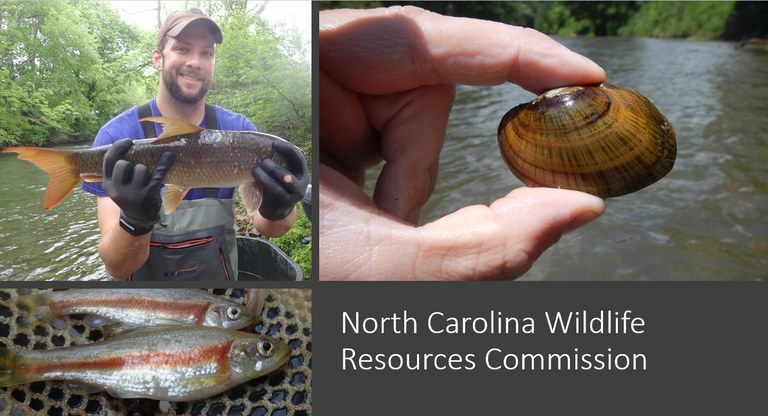May 2019 TRBN Partner Spotlight

What part of our freshwater aquatic ecosystem do you really admire?
I really admire the incredible aquatic biodiversity of NC and the Tennessee River basin. The Tennessee River basin literally has hundreds of endemic aquatic species and there is no other place I would rather be.
What is your role with NC Wildlife Resources Commission (NCWRC)?
I have been the Western Region Aquatic Wildlife Diversity Coordinator for NCWRC since April 2018. My role is to lead conservation and monitoring of aquatic mollusks, crayfish, and nongame fishes in the New, Savannah, Little Tennessee, Hiwassee, French Broad, and Watauga river basins in North Carolina. My position is responsible for survey and study design, habitat assessments, identification of organisms to species, recording data, database management, and analysis of population status for common, state listed, and federally listed freshwater mussels, fish, crayfish, and aquatic snails. Responsibilities also include providing technical guidance to local, state, and federal governmental agencies, conservation organizations, educational institutions, private landowners, and the general public. Finally, my position provides input on federal, state, local, and private projects that may impact listed species by attending on-site meetings and developing written comments.
What is the mission of NC Wildlife Resources Commission?
To conserve North Carolina’s wildlife resources and their habitats and provide programs and opportunities that allow hunters, anglers, boaters and other outdoor enthusiasts to enjoy wildlife-associated recreation.
How did your organization come about?
In response to declining wildlife resources across North Carolina in the early 20th century, the N.C. General Assembly mandated that a state wildlife agency be formed in 1947 to protect wildlife resources and enforce wildlife laws.
How can people get involved or connected with NCWRC? What type of assistance could they provide to you?
Keeping up with NCWRC through our website (ncwildlife.org), social media (e.g. Facebook, Instagram, etc.), and by subscribing to our magazine Wildlife in North Carolina, are good ways to stay connected with the NCWRC and our biologists. Subscribing to our wildlife magazine, buying hunting and fishing licenses, getting involved in our conservation programs (ncwildlife.org/Conserving/programs), or supporting NCWRC non-game directly through the purchase of the NC Wildlife Conservation License Plate or a donation to the Nongame and Endangered Wildlife Fund are great ways to assist NCWRC in our conservation efforts.
What has been your favorite project?
My favorite project has been habitat modeling and population monitoring of Smoky Dace (Clinostomus sp. cf. funduloides), which are an undescribed species found in the Little Tennessee and Hiwassee River basins. I really enjoy this work because there aren’t many people who have worked on the species and we are constantly finding new locations where this species occurs and how it operates.
What has been your proudest moment for your organization?
My proudest moment for my organization was during an Asheville showing of the TRBN sponsored Freshwater Illustrated film, Hidden Rivers, that was organized by my coworker Andrea Leslie. It was a great event that highlighted work done by several biologists at NCWRC and the unique aquatic biodiversity we have in NC and the Tennessee River basin.
Anything special happening this year?
We are reintroducing the Wavy-rayed Lampmussel, Lampsilis fasciola, into the mainstem French Broad River watershed. This species has been extirpated in this watershed for over 100 years and is one of our latest projects trying to restore historical aquatic biodiversity the French Broad River system.
How did you hear about the Tennessee River Basin Network?
A coworker and member of TRBN, Andrea Leslie, introduced me to the partnership when I first started working for NCWRC in 2016.
Why do you participate in the Tennessee River Basin Network?
I participate in the TRBN because this is one of the most diverse partnerships that I know of. The TRBN has so much potential for bringing folks together and creating real positive change across the conservation landscape.
How could NC Wildlife Resources Commission support others in our Network?
The NCWRC can support others throughout the network by providing data, collaboration, and support in TRBN led projects.






















